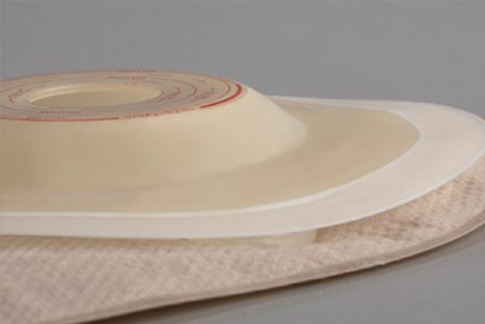Choosing the Right Ostomy Skin Barrier
The skin barrier — also called a wafer, flange, or baseplate — is an essential part of your ostomy pouching system. Its job is to stay in place, protect your peristomal skin, and connect the pouch securely to the stoma.
To choose the right ostomy skin barrier, you’ll need to consider the size and shape of the stoma, the characteristics of the skin around it, and the output from your stoma.
If the skin of your abdomen is smooth and relatively flat, and if your stoma protrudes somewhat, then a standard skin barrier should work well for you. If your stoma is flush with the skin or retracted, a convex skin barrier can help you get a good fit. And if your skin is scarred, deeply creased, or uneven, you may need certain ostomy accessories, such as barrier rings or strips.
Some skin barriers are designed to seal in liquid output, and these are best for people with urostomies or ileostomies. People with more solid, formed output may prefer a skin barrier with gentle adhesion. If your skin is sensitive to the adhesive, try different products.
Pros and Cons of Pre-Sized Skin Barriers
These barriers have a pre-cut opening for the stoma. Use a stoma measuring guide to determine the right size to order. The gap between the stoma and the edge of the guide or the opening in the barrier should be no larger than 1/8 inch.
Pros: If your stoma is round and its size isn’t changing, pre-cut barriers are the easiest way to go. No cutting, no molding — just put it on.
Cons: Pre-cut barriers won’t fit stomas that are oval or irregular in shape. If your stoma is still shrinking after surgery, the pre-cut opening might become too large.


Pros and Cons of Cut-to-Fit Skin Barriers
Not everyone has a perfectly round stoma. Is your stoma more oval or irregular, or is it still changing size after surgery? You can cut an opening in these skin barriers, with the help of the pre-printed guide, that’s the exact shape and size you need.
Pros: A precise fit is crucial to prevent skin barrier leaks. Cutting your own opening ensures the best fit.
Cons: Measuring and cutting the skin barrier adds time to the process of changing your ostomy system. If you accidentally cut an opening that’s too big, or if you puncture the pouch itself, you’ll have to discard the pouch.
About Moldable Skin Barriers
A moldable skin barrier is stretchy, so that it hugs the stoma for a tight fit. No prep work is required — just put the barrier on. Moldable barriers are recommended for people who may not have the dexterity or vision required to cut an opening in their skin barrier. Also, one study found that moldable barriers were effective in preventing and healing peristomal skin complications.


About Convex Skin Barriers
A convex skin barrier is bowl-shaped, helping to ensure a secure fit with the skin barrier in certain circumstances. Convexity can help the stoma protrude if it’s flush with the skin or retracted; flatten wrinkles and creases in the abdomen; and adjust the stoma so it tips in the right direction. All these benefits help the pouching system adhere closely, avoiding gaps in the seal.
Convex skin barriers may be soft and bendable, so they conform to your body, or firm, so they provide more support. You can add barrier rings to create even more convexity.
Related Products

